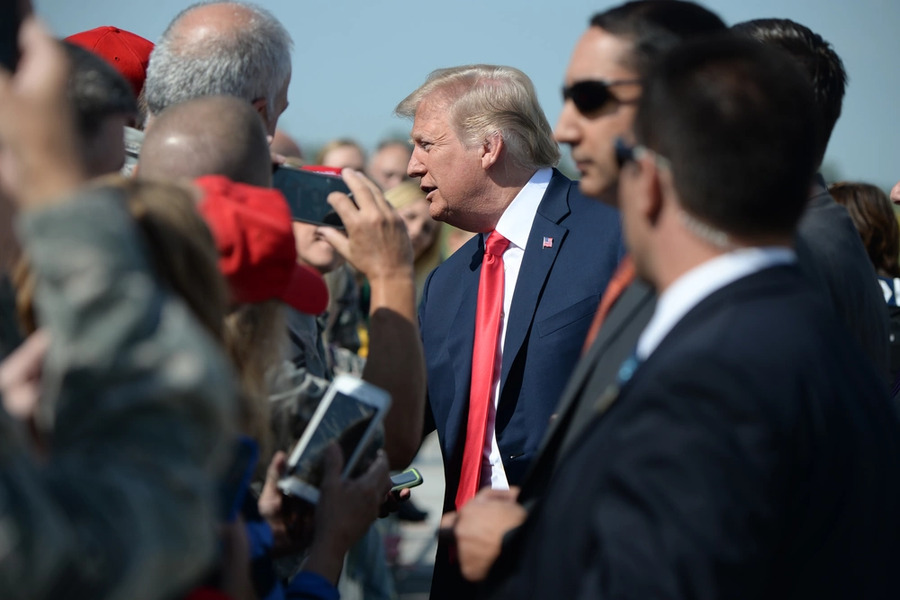Classified Legislation: Tracking Congress’s Library of Secret Law
Most citizens assume that all of the law Congress writes is public. That is not, in fact, true. Our general norm of publishing law has a significant and largely overlooked legislative exception: classified addenda associated with three annual national security acts.
Published by The Lawfare Institute
in Cooperation With

Most citizens assume that all of the law Congress writes is public. That is not, in fact, true. Our general norm of publishing law has a significant and largely overlooked legislative exception: classified addenda associated with three annual national security acts. If a four decade-old practice holds, the Intelligence Authorization Act (IAA), the National Defense Authorization Act (NDAA), and the Department of Defense Appropriations Act (DODAA) now moving through Congress will all do part of their lawmaking inside these classified documents.
Usually, when people discuss secret law, they are referring to classified or otherwise unpublished presidential orders, Justice Department memoranda, or Foreign Intelligence Surveillance Court decisions. In a recent article, I conclude that this claim of secret law’s existence is generally credible and important, and that secret law is being produced by Congress as well.
To date, Congress’s classified lawmaking has received scant attention outside of a small circle of legislators, committee staff, White House and agency officials, and budgeteers. Yet the public record shows that these addenda govern enormously consequential classified U.S. government activities, including surveillance, covert action, and the use of missile-armed drones.
By using the term “secret law” to describe what Congress is doing here, I do not mean to suggest anything nefarious. Having served in all three branches of government, including in the Intelligence Community, I have the greatest regard for the public servants who draft and implement secret law, and for the very real national security considerations that drive its creation. I mean only that there is a body of law that meets the following definition: legal authorities that require compliance that are classified or otherwise unpublished.
In this post I outline the origins, purposes, and dilemmas of these classified legal authorities, and the varieties of legislative references to them. I summarize the findings of my empirical analysis, recently published in the Harvard National Security Journal. The addenda are an example of a broader three-branch phenomenon of non-published law that we can reasonably term secret law―one with which the nation needs to come to terms.
Origins and Enduring Challenges
Congress faces a dilemma regarding national security activities: how do elected representatives wield the legislature’s legal instrument of Public Law to fund, structure, and manage activities that must not be disclosed to the public?
With the evidently sole exception of a brief experiment with secret statutes around the time of the War of 1812, the answer until the 1970s was generally worded public statutes, coupled with detailed confidential communications between congressional committees and the Executive Branch. Sealed letters from the appropriations committees explained what money was intended for which classified programs.
The 1970s Church-Pike investigations of intelligence abuses, however, led many observers to believe that trust in the Executive Branch’s national security apparatus and in non-legislated congressional oversight had been misplaced. A new constitutional “accommodation” on intelligence was forged. One of its central purposes was to allow detailed oversight and regulation by Congress, while protecting classified information.
Classified addenda were an innovation of the post-Church-Pike “accommodation.” Over the years, these addenda have variously been termed classified annexes, reports, appendices, supplements, and schedules. The public legislative record suggests that these addenda (most commonly called annexes) include tables (schedules) of personnel levels and budget authorizations and appropriations, plus explanatory discussion and other programmatic directives. Often, the classified addenda are referenced directly by the statute. Frequently, these addenda are appended to the reports congressional committees write explaining Congress’s intent in the annual IAAs, NDAAs, and DODAAs.
The value of classified addenda is clear: they allow Congress to execute its constitutional legislative and spending powers even regarding the most sensitive government activities. There is also no obvious alternative. This mechanism has now been relied upon longer than some involved in the process have been alive. They do not leak.
On the other hand, there is little transparency because of the limited nature of references to the addenda. No addendum has ever been published, even in redacted form. Not much is publicly known about their substantive content. Nothing is publicly known about their length. An individual addendum could be two pages long, or 20, or 200. Each of the committees invite Members to review the addenda in a secure room, but few do.
Legal Content and Empirical Analysis
In legal terms, classified legislating is inherently problematic. It runs against our general constitutional norm of publication of the law. The addenda are also top secret documents outside the four corners of the statute. They do not themselves satisfy the Constitution’s lawmaking requirement of bicameralism and presentment. Although Congress directs that addenda be shared with the President, the President signs bills, not reports or addenda.
Congress’s legal maneuver in this context is statutory text that gives the addenda legal force. My empirical study documents a variety of statutory references that point to the addenda and say “the law is in there”―in a classified document, in a safe, in a secure room.
Congress commonly writes statutory provisions that cap or otherwise condition money and personnel as specified in the addenda. Many concern intelligence community management. Others suggest impact on operations, such as provisions limiting funds for covert action, or those earmarking $4.8 billion for “classified programs, described…in the classified annex” at the height of the Iraq war. Other ad hoc statutory provisions say that particular programs must adhere to stipulations in the addenda. Examples over the years have included Pentagon missile programs, and a new “counter-terrorism foreign intelligence program…described in the Classified Annex” to replace the controversial Total Information Awareness domestic datamining program Congress terminated in the DODAA for 2004.
The most standard―and potentially most sweeping―provisions are incorporation provisions. These purport to give the force of law to addenda in substantial part or in full. Virtually all annual IAAs, for example, stipulate in Sec. 102 that funding authorizations and personnel levels “are those specified in the classified Schedule of Authorizations.” Explanatory report language often states that the classified Schedule “is incorporated by reference in the Act and has the legal status of public law.” The Intelligence Community’s top lawyer agrees. NDAAs for 1991-2002 and DODAAs for 1991-1995 had the most expansive incorporation provisions, stating that their entire classified addenda were incorporated into the statute. In recent years, recurring provisions in the NDAAs and DODAAs give legal force to budget levels in their classified addenda.
Several conclusions emerge from analysis of 36 years of references to classified addenda in statutes and reports.
First, classified legislating using the addenda is a well-established exception to the norm of publication of the law. Over 36 years, Congress has written 124 provisions in 68 Public Laws reasonably read to give classified addenda legal force (see Table 1 below). About half were full or partial incorporation provisions. Meanwhile, 45 last-in-time reports (most often Conference Report Joint Explanatory Statements) have referenced incorporation.

All told, adding in committee reports, Congress has written at least 271 reports with classified addenda since 1977 (see Table 2 at the end of the full article).
Second, Congress’s classified legislating has been a bipartisan practice. Through 2015, six presidents and 37 congressional majorities of both parties have participated.
Third, the public legislative record reflects both consistency and change―and an upward trend in statutory references to these classified addenda. In recent years, even as Congress’s overall legislative productivity has declined, Congress has sharply accelerated passage of provisions reasonably read to give classified addenda legal force. Congress wrote more statutory provisions giving addenda legal force in the two most recently completed Congresses (2011-15) than during the first eight Congresses (1977-92) of the practice.
Fourth, in using the addenda, Congress has been legislating at the height of its constitutional authority―the power of the purse―and has been doing more than just handing spy agencies cash. The common perception that the addenda are “just a pile of budget numbers” is belied by repeated references to detailed congressional direction in the addenda.
Coming to Terms with Congress’s Secret Law
In coming to terms with secret law, the nation could decide to end it, live with the status quo, or reform it. In my longer article on the subject, I outline some principles and proposals if we do decide that some quantum of secret law is necessary, but that we want to govern it more consciously, explicitly, and consistently.
These rules of the road include:
- First, that public law is supreme. This Public Law Supremacy Rule has a corollary: secret law should not grow government legal authority beyond the public’s understanding of the law the public can read and change.
- Second is an Anti-Kafka Principle: secret criminal law is impermissible, and secret law must not otherwise impose duties on the public.
- Third is a Shallow Secrecy Principle: secret law’s creation should be announced, through public “bell ringers,” and the legal basis for secret activities should be explained to the greatest extent consistent with protecting classified factual information.
- Fourth, there should be steps―such as presumptive sunset and declassification dates―to counteract classified legal inertia and ensure that public officials take ownership of secret law they inherit and seek to perpetuate.
- Finally, there should be plurality of review within government, including review processes within each branch of government, to prevent creation of secret law known only to one branch or one agency. So it can legislate with knowledge of the full legal landscape, Congress should have access to all secret law.
Congress does a good job signaling its secret law creation: the statutory provisions that create law in the addenda are there for everyone to read. Legislative process also has multiple stages of review, involving multiple branches. On the other hand, statutory provisions making law inside the classified addenda do not require sunsets or declassification reviews. Congress should provide these. Congress should also provide assurances that the addenda do not grow government power beyond what the people would understand it to be based on reading publicly available law, and that the addenda do not create secret criminal law nor impose duties on the public. In a republic of public law, these are valuable steps toward coming to terms with Congress’s secret law, without compromising necessarily secret factual information, operations, sources, and methods.




-final.png?sfvrsn=b70826ae_3)
